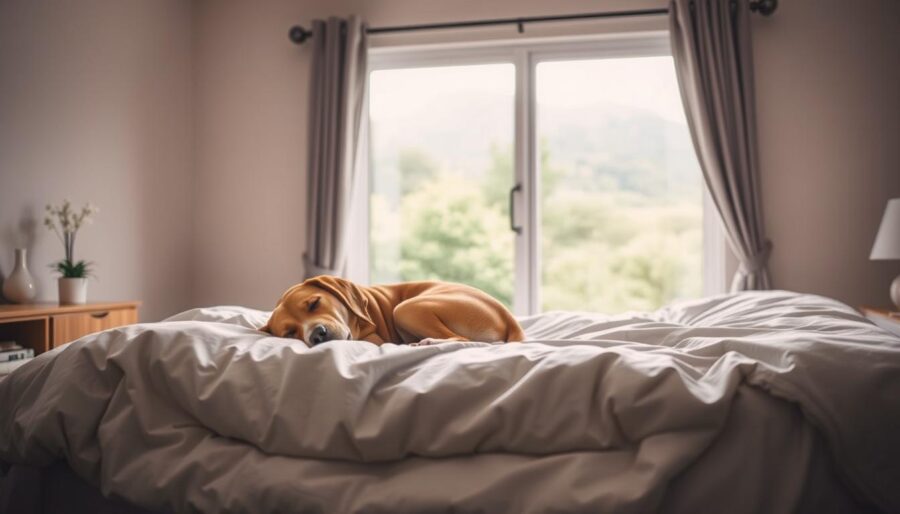Managing pet noise, like barking dogs and loud street sounds, is key to sleeping better. Neighborhood animals and noise from outside often interrupt your sleep. Using sound barriers outdoors helps a lot. This piece explores ways to lessen these disturbances for better sleep.
Understanding Pet Noise and Its Impact on Sleep
Barking dogs can really mess with your sleep and health. Studies reveal that non-stop pet noise can break your sleep, which can make you stressed. It’s super important to manage pet noise to keep your home peaceful.
Noises from pets around your place, especially barking dogs, can mess up your sleep. Losing sleep regularly can lead to health problems. This includes stress, worse thinking skills, and a lower quality of life.
Knowing how to control pet noise is key to sleeping better. By reducing barking noises, you’ll feel better and more at ease.
Identifying Common Noise Issues with Pets
Getting to know the pets around your neighborhood can shed light on noise problems. Dogs barking at night is a big issue. Figuring out why this happens can lead to ways to keep things quieter.
Common pet noises include:
- Barking when they see other animals, cars, or people they don’t know.
- Making noise at night because they miss their owners or are guarding their home.
- Being loud when they are very active or try to get out by scratching doors and windows.
These actions can upset not just your family but also your neighbors. This shows why knowing how to manage pet noise is crucial.
| Noise Issue | Common Sources | Potential Solutions |
|---|---|---|
| Barking Dogs | External stimuli, such as cars or other animals | Behavioral training, noise-absorbing materials |
| Nighttime Vocalization | Separation anxiety, territorial instincts | Comfort items, anti-anxiety products |
| Indoor Noise | Playfulness, scratching | Toys, exercise, quiet zones |
Solving these noise problems can make life better for everyone in the home and nearby. It helps keep all pets and people happier.
Creating a Peaceful Home Environment
A calm home is key to better behavior in pets and good sleep for you and them. To do this, manage noise well with different plans. Using sound barriers is one smart way to keep pet noise down.

Start by soundproofing important parts of your home. Put up thick curtains, add rugs, and seal windows and doors to block outside noise. This helps with pet sounds and makes your home quieter and more peaceful.
Another top tip is to change your home’s setup. Move where your pet sleeps to a quieter spot, away from windows and outside walls. This lowers noise from outside, helping your pet stay relaxed.
Here are some helpful changes you can make:
- Replace old windows with double-pane ones to cut down on noise.
- Add noise-stopping insulation in walls and ceilings.
- Lay carpets or rugs to keep noise from traveling through floors.
- Create a quiet spot with materials that take in sound for your pet.
If you have a yard or garden, improve it by building sound barriers. Fences made of thick wood or vinyl can block neighborhood sounds. Planting thick bushes also works as a natural sound stopper, and it looks nice too.
By using these ideas, you make your home quieter and nicer for you and your pets. It’s great for lowering pet stress and making your home feel more together.
Training Your Dog to Be Quieter
It’s crucial to teach your dog to be less noisy. Using special training methods can make your dog bark less. This leads to a quieter home for all. Here are some ways to help control your dog’s barking.
Behavioral training is a top method. It teaches your dog when barking is okay and when it’s not. First, find out what makes your dog bark. Then, slowly get your dog used to these things. Reward them when they stay quiet.
Another method uses rewards. Give your dog treats or praise when they don’t bark. Stay consistent to help your dog learn good behavior.
Sometimes, training is tough. You might face stubbornness or confusion. Keep trying and stay patient. If you still struggle, think about getting help from a dog trainer who knows about noise control.
- Identify triggers
- Use behavioral training
- Implement a reward system
- Be patient and consistent
- Seek professional help if needed
With effort and the right training, your dog will bark less. This will make your home quieter and happier.
Utilizing Calming Products for Your Pet
To control pet noise effectively, calming products can help. They lessen stress, which leads to less barking. These items are made to make anxious pets feel relaxed. This makes your home more peaceful for you and your pet.
Anxiety vests are popular for calming pets. Products like the Thundershirt are tight, like swaddling a baby, and can soothe your dog. They work well during loud noises like thunderstorms or fireworks.
Calming treats are key in pet noise control, too. Brands like Zesty Paws and PetHonesty have treats with calming ingredients like chamomile. These treats don’t sedate your pet but help them relax. Give them before things like vet visits to help lower anxiety.
Playing special pet music is another way to keep things quiet. Through a Dog’s Ear makes music that calms dogs. It works by soothing their nervous system. This music is useful during stressful times.
| Product | Brand | Key Benefits |
|---|---|---|
| Anxiety Vest | Thundershirt | Applies gentle pressure to calm pets |
| Calming Treats | Zesty Paws | Infused with natural calming ingredients |
| Specialized Music | Through a Dog’s Ear | Scientifically proven to calm dogs |
Using these calming products can make your home quieter and happier. They help whether your dog barks a lot or gets nervous easily. These tools offer a lot of support in making pets feel more relaxed.
The Role of Outdoor Noises in Pet Anxiety
Understanding how outdoor noises affect your pet’s anxiety is crucial. Sounds like thunder, traffic, and construction can stress dogs out. This can make them bark more and act restless. Knowing what bothers them is the first step to helping them feel better.
People have found that keeping pets comfy outside can make a big difference. You might help your dog by soundproofing your home or making a quiet space inside. This can lower their anxiety and make everyone feel more comfortable outside.

- Thunderstorms cause excessive pacing and barking.
- Construction noise often leads to agitated behavior.
- High-frequency traffic sounds can trigger anxiety episodes.
Building a peaceful spot at home with special products and training can help with outdoor noise stress. Using everything you can to make your pet happier will cut down on their anxiety from noises.
Techniques for Managing Your Pet’s Anxiety
Reducing your pet’s anxiety involves several steps. These include making their environment calmer, training them, and using calming products. You can lessen their stress by making their surroundings secure.
Adding sound barriers in your home is a good tactic. It helps block outside noise that might upset your pet. This is especially important in cities with lots of traffic noise.
Also, certain calming products can help. Things like essential oil diffusers, calming collars, and special treats work well. Brands such as Adaptil and ThunderShirt are known to relax pets and reduce their stress.
Training your pet to respond to calming commands is crucial. Commands like “relax” or “settle” can teach them to calm down. Using positive reinforcement makes them link these commands to feeling safe.
Combining these strategies can make your home peaceful for your pet. It minimizes loud reactions from anxious pets. Addressing each part of your pet’s health leads to a happier pet.
Monitoring Noise Levels in the Neighborhood
Keeping the noise down in your area is vital for peace and the well-being of everyone. Start with apps and devices that track noise levels. These can show you where the noise is loudest.
Talking with your neighbors helps too. Discuss noise control and set quiet times to cut down on disturbances. Encourage other pet owners to keep their pets quiet, which keeps everyone happy.
Adding sound barriers is a smart move as well. Planting hedges or putting up fences can block out noise. This makes outside more peaceful for everyone.
Here are some ways to keep your neighborhood quiet:
- Using smartphone apps to measure noise levels.
- Collaborating with neighbors for designated quiet times.
- Installing sound barriers such as fences and hedges.
- Encouraging pet noise etiquette among community members.
Promising to work together on noise control makes for a calm place for all, pets included. Follow these steps for a more peaceful neighborhood.
When to Consider Professional Noise Control Services
Sometimes, handling pet noise at home works well. But, you might need experts if the noise badly affects your life. When your dog’s barking or other loud sounds take a toll, professional help could be the answer.
Experts can check your home’s sound setup and suggest specific fixes. They might add thicker walls, better windows, or soundproof doors. They use advanced methods to keep your place quiet, yet comfy and nice-looking.
Pet noise experts can really help by training your pet. They find out what makes your pet bark or feel stressed and make plans to fix it. This way, your home becomes quieter and calmer.
Think about getting professional help if you notice these issues:
- Your pet is still stressed or anxious even after you try to manage the noise at home.
- There’s a lot of barking and your neighbors complain.
- Loud noises from things like construction are too strong for normal solutions.
Choosing professional noise control makes life better for you and your pet. It also makes your home more peaceful and cozy. Custom solutions can handle tough noise problems. This means a quieter, happier place for you and your pet.
Maintaining a Healthy Sleep Environment for You and Your Pet
Creating a peaceful sleep space is crucial for you and your pet. Addressing noise issues, training your pet, and blocking outside noise helps a lot. Adding heavy curtains or a white noise machine reduces noise, making sleep easier.
Being consistent is important. A regular noise management routine helps your pet stay calm. By keeping an eye on neighborhood noise, you can deal with new noise quickly. This may mean getting better soundproofing or finding experts in pet noise control. Staying alert helps a lot.
A quiet sleep space is good for you and your pet. Working on noise issues and using sound barriers make a restful place. By being careful and choosing the right approaches, you and your pet will find peace and rest at home.




